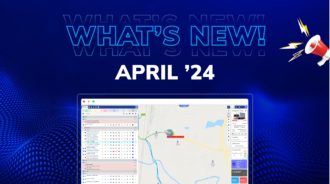In today’s fast-paced business environment, efficiency is key, especially in field services. One crucial aspect of achieving this efficiency is through effective field service route optimization. This process not only saves time and resources but also enhances customer satisfaction and reduces operational costs. In this comprehensive guide, we’ll explore ten essential tips for optimizing your field service routes, leveraging the power of advanced fleet management software. Our focus is to keep the language simple and the content highly informative, aligning with the latest trends in field service management.
1. Understanding the Basics of Route Optimization
Before diving into the technicalities, it’s essential to grasp what field service route optimization entails. It involves planning the most efficient routes for field service vehicles, considering factors like distance, travel time, customer locations, and service windows. The primary goal is to ensure timely service delivery while minimizing travel time and costs.
2. Leveraging Advanced Fleet Management Software
Advanced fleet management software plays a pivotal role in route optimization. It uses algorithms to calculate the most efficient routes, taking into account various constraints and real-time data. By integrating this software into your operations, you can automate route planning, reduce manual errors, and increase overall efficiency.
3. Prioritizing Customer Needs and Preferences
Customer satisfaction is paramount in field service management. Tailoring your route plans to accommodate customer preferences, such as specific time windows for appointments, can significantly enhance customer experience and loyalty.
4. Analyzing Traffic Patterns and Road Conditions
An effective route optimization strategy must consider real-time traffic data and road conditions. This approach helps in avoiding delays and ensuring timely service, which is crucial for maintaining a positive customer relationship.
5. Scheduling and Dispatching Efficiently
Efficient scheduling and dispatching are vital components of route optimization. By scheduling services in a logical order and dispatching the nearest available technician, you can reduce travel time and increase the number of service calls completed per day.
6. Utilizing Real-Time Data and GPS Tracking
GPS tracking and real-time data are invaluable for dynamic route optimization. They provide insights into vehicle locations, allowing for quick rerouting in case of unexpected traffic or emergencies.
7. Emphasizing Regular Training and Updates
Regularly training your staff on the latest route optimization techniques and software updates ensures that they are equipped to handle challenges and make informed decisions on the field.
8. Encouraging Driver Feedback and Participation
Drivers are on the front lines of field services. Encouraging their feedback and participation in route planning can provide practical insights that improve route optimization strategies.
9. Monitoring Performance Metrics
Tracking key performance metrics such as fuel consumption, time per service call, and customer satisfaction rates can help you assess the effectiveness of your route optimization strategies and identify areas for improvement.
10. Continuously Improving and Adapting
The field service landscape is constantly evolving. Staying updated with the latest trends, technologies, and customer expectations is crucial for continuous improvement in route optimization.
Conclusion
Implementing effective field service route optimization is a dynamic process that requires a balance of technology, strategy, and human insight. By following these ten tips and integrating advanced fleet management software, businesses can achieve significant improvements in efficiency, cost reduction, and customer satisfaction. As we continue to embrace technological advancements, the potential for further optimization in field services is limitless.
Frequently Asked Questions (FAQs)
1. What is Field Service Route Optimization?
Field service route optimization involves using technology to determine the most efficient routes for field service personnel. This process aims to save time, reduce costs, and enhance service delivery by considering factors like traffic, distance, customer preferences, and vehicle capabilities.
2. How does Fleet Management Software improve route optimization?
Advanced fleet management software enhances route optimization by providing real-time tracking, sophisticated route planning algorithms, and data analysis. It helps in identifying the most efficient routes, managing fleet operations, and reducing operational costs.
3. Can route optimization impact customer satisfaction?
Absolutely. Route optimization directly impacts customer satisfaction by ensuring timely service delivery, minimizing delays, and allowing for better communication with customers regarding service times and expectations.
4. What role does real-time data play in route optimization?
Real-time data is crucial for making informed decisions during route planning. It provides updates on traffic conditions, weather changes, and other unforeseen events, enabling adjustments to be made quickly to maintain route efficiency.
5. How important is driver communication in route optimization?
Effective communication with drivers is essential for successful route optimization. Regular training on route optimization tools and providing drivers with technology for real-time updates and feedback are vital for maintaining efficient operations.
6. Is eco-friendliness a consideration in route optimization?
Yes, eco-friendliness is increasingly important in route optimization. Planning efficient routes reduces fuel consumption, decreases the carbon footprint, and aligns with the growing trend of environmental responsibility in business operations.
7. How often should routes be reviewed and adjusted?
Routes should be reviewed and adjusted regularly due to the dynamic nature of field service operations. Factors like changing traffic patterns, customer needs, and service areas can necessitate frequent adjustments for optimal efficiency.
8. What is geofencing and how is it used in route optimization?
Geofencing is a technology that creates virtual geographic boundaries. In route optimization, it’s used to track when vehicles enter or exit specific areas, aiding in managing field operations and ensuring compliance with planned routes.
9. Can predictive analytics be used in route optimization?
Predictive analytics is a powerful tool in route optimization. It uses historical data to forecast potential route disruptions and helps in planning ahead to minimize delays and optimize service delivery.
10. How does route optimization contribute to the overall success of a field service business?
Route optimization contributes significantly by improving operational efficiency, reducing costs, enhancing customer satisfaction, and promoting sustainable business practices. It’s a key element in maintaining a competitive edge in the field service industry.



